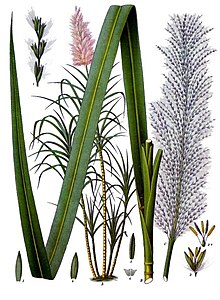
Sugarcane or sugar cane is a species of tall, perennial grass (in the genus Saccharum, tribe Andropogoneae) that is used for sugar production. The plants are 2–6 m (6–20 ft) tall with stout, jointed, fibrous stalks that are rich in sucrose,[1] which accumulates in the stalk internodes. Sugarcanes belong to the grass family, Poaceae, an economically important flowering plant family that includes maize, wheat, rice, and sorghum, and many forage crops. It is native to the warm temperate and tropical regions of India, Southeast Asia, and New Guinea.
Sugarcane was an ancient crop of the Austronesian and Papuan people. The best evidence available today points to the New Guinea area as the site of the original domestication of Saccharum officinarum.[2] It was introduced to Polynesia, Island Melanesia, and Madagascar in prehistoric times via Austronesian sailors. It was also introduced to southern China and India by Austronesian traders around 1200 to 1000 BC. The Persians and Greeks encountered the famous "reeds that produce honey without bees" in India between the sixth and fourth centuries BC. They adopted and then spread sugarcane agriculture.[3] Merchants began to trade in sugar, which was considered a luxurious and expensive spice, from India. In the 18th century, sugarcane plantations began in the Caribbean, South American, Indian Ocean, and Pacific island nations. The need for sugar crop laborers became a major driver of large migrations, some people voluntarily accepting indentured servitude[4] and others forcibly imported as slaves.[5]
Grown in tropical and subtropical regions, sugarcane is the world's largest crop by production quantity, totalling 1.9 billion tonnes in 2020, with Brazil accounting for 40% of the world total. Sugarcane accounts for 79% of sugar produced globally (most of the rest is made from sugar beets). About 70% of the sugar produced comes from Saccharum officinarum and its hybrids.[6] All sugarcane species can interbreed, and the major commercial cultivars are complex hybrids.[7]
White sugar is produced from sugarcane in specialized mill factories. Sugarcane reeds are used to make pens, mats, screens, and thatch. The young, unexpanded flower head of Saccharum edule (duruka) is eaten raw, steamed, or toasted, and prepared in various ways in Southeast Asia, such as certain island communities of Indonesia as well as in Oceanic countries like Fiji.[8] The direct use of sugar cane to produce ethanol for biofuel is projected to potentially surpass the production of white sugar as an end product.
- ^ Papini-Terzi, Flávia S.; Rocha, Flávia R.; Vêncio, Ricardo ZN; Felix, Juliana M.; Branco, Diana S.; Waclawovsky, Alessandro J.; Del Bem, Luiz EV; Lembke, Carolina G.; Costa, Maximiller DL; Nishiyama, Milton Y.; Vicentini, Renato (21 March 2009). "Sugarcane genes associated with sucrose content". BMC Genomics. 10 (1): 120. doi:10.1186/1471-2164-10-120. ISSN 1471-2164. PMC 2666766. PMID 19302712.
- ^ John N. Warner, “Sugar Cane: An Indigenous Papuan Cultigen.” Ethnology, vol. 1, no. 4, 1962, pp. 405–11.
- ^ "Agribusiness Handbook: Sugar beet white sugar" (PDF). Food and Agriculture Organization, United Nations. 2009. Archived from the original (PDF) on 5 September 2015. Retrieved 6 February 2012.
- ^ "Indian indentured labourers". The National Archives, Government of the United Kingdom. 2010. Archived from the original on 20 September 2019. Retrieved 15 April 2022.
- ^ Mintz, Sidney (1986). Sweetness and Power: The Place of Sugar in Modern History. Penguin. ISBN 978-0-14-009233-2.
- ^ "Plants & Fungi: Saccharum officinarum (sugar cane)". Royal Botanical Gardens, Kew. Archived from the original on 4 June 2012.
- ^ Vilela, Mariane de Mendonça; Del-Bem, Luiz-Eduardo; Van Sluys, Marie-Anne; De Setta, Nathalia; Kitajima, João Paulo; et al. (2017). "Analysis of Three Sugarcane Homo/Homeologous Regions Suggests Independent Polyploidization Events of Saccharum officinarum and Saccharum spontaneum". Genome Biology and Evolution. 9 (2): 266–278. doi:10.1093/gbe/evw293. PMC 5381655. PMID 28082603.
- ^ "Consumer Preference for Indigenous Vegetables" (PDF). World Agroforestry Centre. 2009. Archived (PDF) from the original on 4 February 2015. Retrieved 7 February 2012.